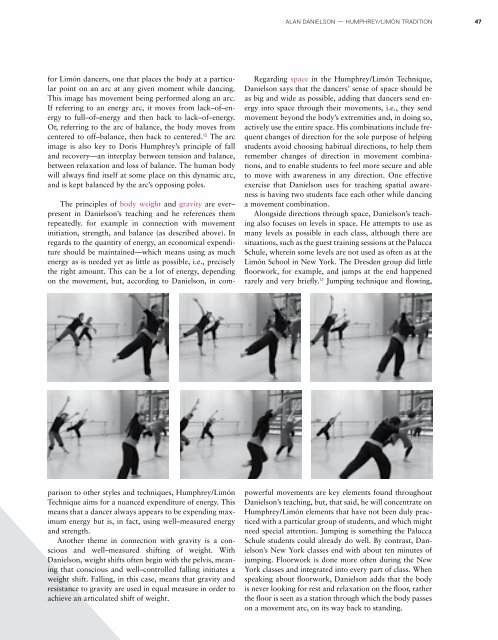Dance Techniques 2010
What does today's contemporary dance training look like? Seven research teams at well known European dance universities have tackled this question by working with and querying some of contemporary dance s most important teachers: Alan Danielson, Humphrey/Limón Tradition, Anouk van Dijk, Countertechnique, Barbara Passow, Jooss Leeder Technique, Daniel Roberts Cunningham Technique, Gill Clarke Minding Motion, Jennifer Muller Muller Technique, Lance Gries Release and Alignment Oriented Techniques. This comprehensive study includes interviews, scholarly contributions, and supplementary essays, as well as video recordings and lesson plans. It provides a comparative look into historical contexts, movement characteristics, concepts, and teaching methods. A workbook with two training DVDs for anyone involved in dance practice and theory. Ingo Diehl, Friederike Lampert (Eds.), Dance Techniques 2010 – Tanzplan Germany. With two DVDs. Berlin: Henschel 2011. ISBN 978-3-89487-689-0 (Englisch) Out of print.
What does today's contemporary dance training look like? Seven research teams at well known European dance universities have tackled this question by working with and querying some of contemporary dance s most important teachers: Alan Danielson, Humphrey/Limón Tradition, Anouk van Dijk, Countertechnique, Barbara Passow, Jooss Leeder Technique, Daniel Roberts Cunningham Technique, Gill Clarke Minding Motion, Jennifer Muller Muller Technique, Lance Gries Release and Alignment Oriented Techniques.
This comprehensive study includes interviews, scholarly contributions, and supplementary essays, as well as video recordings and lesson plans. It provides a comparative look into historical contexts, movement characteristics, concepts, and teaching methods. A workbook with two training DVDs for anyone involved in dance practice and theory.
Ingo Diehl, Friederike Lampert (Eds.), Dance Techniques 2010 – Tanzplan Germany. With two DVDs. Berlin: Henschel 2011. ISBN 978-3-89487-689-0 (Englisch) Out of print.
Create successful ePaper yourself
Turn your PDF publications into a flip-book with our unique Google optimized e-Paper software.
Alan Danielson — Humphrey/Limón Tradition<br />
47<br />
for Limón dancers, one that places the body at a particular<br />
point on an arc at any given moment while dancing.<br />
This image has movement being performed along an arc.<br />
If referring to an energy arc, it moves from lack–of–energy<br />
to full–of–energy and then back to lack–of–energy.<br />
Or, referring to the arc of balance, the body moves from<br />
centered to off–balance, then back to centered. 12 The arc<br />
image is also key to Doris Humphrey’s principle of fall<br />
and recovery—an interplay between tension and balance,<br />
between relaxation and loss of balance. The human body<br />
will always find itself at some place on this dynamic arc,<br />
and is kept balanced by the arc’s opposing poles.<br />
Regarding space in the Humphrey / Limón Technique,<br />
Danielson says that the dancers’ sense of space should be<br />
as big and wide as possible, adding that dancers send energy<br />
into space through their movements, i.e., they send<br />
movement beyond the body’s extremities and, in doing so,<br />
actively use the entire space. His combinations include frequent<br />
changes of direction for the sole purpose of helping<br />
students avoid choosing habitual directions, to help them<br />
remember changes of direction in movement combinations,<br />
and to enable students to feel more secure and able<br />
to move with awareness in any direction. One effective<br />
exercise that Danielson uses for teaching spatial awareness<br />
is having two students face each other while dancing<br />
a movement combination.<br />
Alongside directions through space, Danielson’s teaching<br />
also focuses on levels in space. He attempts to use as<br />
many levels as possible in each class, although there are<br />
situations, such as the guest training sessions at the Palucca<br />
Schule, wherein some levels are not used as often as at the<br />
Limón School in New York. The Dresden group did little<br />
floorwork, for example, and jumps at the end happened<br />
rarely and very briefly. 13 Jumping technique and flowing,<br />
The principles of body weight and gravity are ever–<br />
present in Danielson’s teaching and he references them<br />
repeatedly. for example in connection with movement<br />
initiation, strength, and balance (as described above). In<br />
regards to the quantity of energy, an economical expenditure<br />
should be maintained—which means using as much<br />
energy as is needed yet as little as possible, i.e., precisely<br />
the right amount. This can be a lot of energy, depending<br />
on the movement, but, according to Danielson, in comparison<br />
to other styles and techniques, Humphrey / Limón<br />
Technique aims for a nuanced expenditure of energy. This<br />
means that a dancer always appears to be expending maximum<br />
energy but is, in fact, using well–measured energy<br />
and strength.<br />
Another theme in connection with gravity is a conscious<br />
and well–measured shifting of weight. With<br />
Danielson, weight shifts often begin with the pelvis, meaning<br />
that conscious and well–controlled falling initiates a<br />
weight shift. Falling, in this case, means that gravity and<br />
resistance to gravity are used in equal measure in order to<br />
achieve an articulated shift of weight.<br />
powerful movements are key elements found throughout<br />
Danielson’s teaching, but, that said, he will concentrate on<br />
Humphrey / Limón elements that have not been duly practiced<br />
with a particular group of students, and which might<br />
need special attention. Jumping is something the Palucca<br />
Schule students could already do well. By contrast, Danielson’s<br />
New York classes end with about ten minutes of<br />
jumping. Floorwork is done more often during the New<br />
York classes and integrated into every part of class. When<br />
speaking about floorwork, Danielson adds that the body<br />
is never looking for rest and relaxation on the floor, rather<br />
the floor is seen as a station through which the body passes<br />
on a movement arc, on its way back to standing.


















